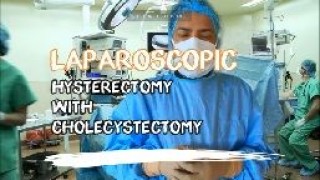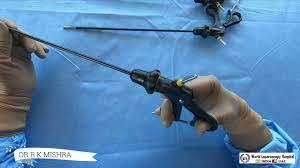Laparoscopic Surgery for Left Ovarian Cyst Removal: A Minimally Invasive Approach
Add to
Share
1,543 views
Report
2 years ago
Description
Introduction: Laparoscopic surgery is a minimally invasive surgical procedure that offers several advantages for the removal of ovarian cysts on the left side. Ovarian cysts are fluid-filled sacs that can develop in the ovaries and may cause discomfort, pain, or other complications. In this comprehensive article, we will explore the details of laparoscopic surgery for left ovarian cyst removal, its benefits, and considerations for this minimally invasive approach. Procedure: Laparoscopic surgery for left ovarian cyst removal involves making a few small incisions in the abdomen, through which specialized instruments and a laparoscope (a thin, illuminated camera) are inserted. The laparoscope provides a magnified view of the pelvic structures, allowing the surgeon to visualize the cyst and surrounding tissues. The surgeon carefully removes the cyst by using the laparoscopic instruments to dissect and separate it from the ovarian tissue. The cyst is then extracted through one of the small incisions or may be drained and removed in pieces. The procedure aims to remove the cyst while preserving the healthy ovarian tissue and minimizing trauma to the surrounding structures. Benefits of Laparoscopic Surgery for Left Ovarian Cyst Removal: Minimally invasive approach: Laparoscopic surgery offers several advantages over traditional open surgery, including smaller incisions, reduced postoperative pain, shorter hospital stays, and faster recovery times. The smaller incisions result in minimal scarring and improved cosmetic outcomes. Preservation of healthy ovarian tissue: The laparoscopic approach allows for precise removal of the cyst while preserving the unaffected ovarian tissue. This is particularly important for women of reproductive age who wish to maintain their fertility and hormonal balance. Reduced risk of complications: Laparoscopic surgery carries a lower risk of complications compared to open surgery. It results in less bleeding, decreased risk of infection, and a lower chance of adhesion formation, leading to a smoother recovery. Considerations for Laparoscopic Surgery for Left Ovarian Cyst Removal: Cyst characteristics: The size, type, and location of the ovarian cyst play a role in determining the feasibility of laparoscopic removal. In some cases, larger or complex cysts may require a different approach or additional considerations. Surgeon expertise: Laparoscopic surgery for left ovarian cyst removal should be performed by a skilled surgeon experienced in laparoscopic techniques. Surgeon expertise is crucial to ensure the success of the procedure and minimize the risk of complications. Patient factors: Individual patient factors, such as previous abdominal surgeries, obesity, or underlying medical conditions, may influence the decision for laparoscopic surgery. The surgeon will assess these factors and determine the most appropriate approach for each case. Recovery and Follow-up: Following laparoscopic surgery for left ovarian cyst removal, patients typically experience a shorter recovery time compared to open surgery. The smaller incisions result in reduced postoperative pain, faster wound healing, and a quicker return to normal activities. Patients are generally able to resume their regular routines within a few days to weeks, depending on individual factors and the extent of the surgery. Regular follow-up appointments with the surgeon are important to monitor the healing process, evaluate any symptoms or concerns, and ensure optimal recovery and long-term outcomes. Conclusion: Laparoscopic surgery is a highly beneficial and minimally invasive approach for the removal of left ovarian cysts. With its advantages of smaller incisions, reduced postoperative pain, preservation of healthy ovarian tissue, and faster recovery times, it has revolutionized the management of ovarian cysts. However, the decision to undergo laparoscopic surgery should be made in consultation with a healthcare professional, taking into account the specific characteristics of the cyst, patient factors, and surgeon expertise. Laparoscopic surgery for left ovarian cyst removal offers numerous benefits, including improved cosmetic outcomes, shorter hospital stays, and a reduced risk of complications. As surgical techniques and technology continue to advance, laparoscopic surgery for left ovarian cyst removal is expected to further improve. Ongoing research and studies aim to refine the procedure, optimize patient outcomes, and explore additional approaches for complex cysts. It is crucial for patients to have a detailed discussion with their healthcare provider to understand the risks, benefits, and alternatives associated with laparoscopic surgery for left ovarian cyst removal. Each case is unique, and the decision to undergo surgery should be based on an individual's specific circumstances, symptoms, and future reproductive goals. Overall, laparoscopic surgery for left ovarian cyst removal provides a highly beneficial and minimally invasive option for patients. By combining the advantages of smaller incisions, reduced postoperative pain, preservation of healthy ovarian tissue, and faster recovery, this approach offers patients a favorable surgical experience and a positive long-term outlook. During a laparoscopic procedure for ovarian cyst removal, the surgeon utilizes a laparoscope, which is a thin, illuminated camera, to visualize the ovaries and carry out the cyst removal. This minimally invasive approach offers several advantages over traditional open surgery. The procedure begins with the patient under general anesthesia. The surgeon makes a few small incisions in the abdomen, typically ranging from 0.5 to 1 centimeter in size. Through these incisions, specialized instruments, including the laparoscope, are inserted. The laparoscope is connected to a high-resolution video monitor, allowing the surgeon to obtain a magnified and clear view of the ovaries and surrounding structures. The camera provides real-time visualization, enabling the surgeon to navigate and perform the procedure with precision. Using the laparoscope, the surgeon carefully examines the ovaries, identifying the location, size, and characteristics of the cyst. This visual information guides the surgeon in determining the appropriate approach for cyst removal. The surgeon uses additional laparoscopic instruments, such as graspers, scissors, or electrocautery devices, to dissect and remove the cyst. The cyst is delicately separated from the ovarian tissue while taking care to preserve the healthy ovarian tissue.
Similar Videos





